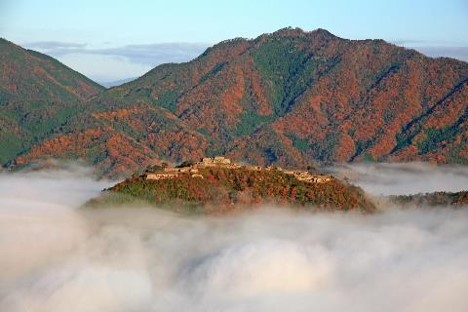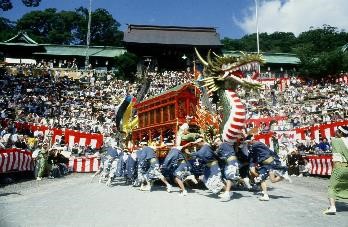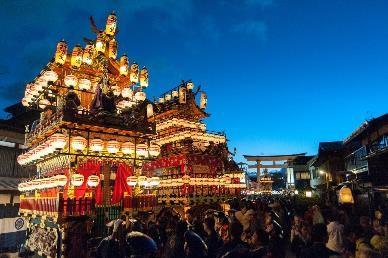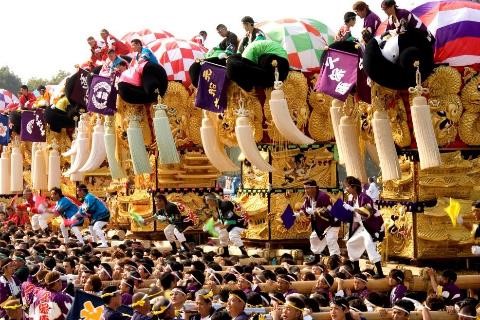
Japan National Tourism Organization (JNTO)
[JNTO] Japan Tourism Topics
2023.09.20
Press release
PDF ver.

1. Seeking the treasures of Morioka & Iwate: places to go in 2023
Morioka was recently spotlighted as the 2nd must-visit destination in the New York Times's "52 Places to Go in 2023", no doubt for its alluring culture, historical architecture, and cuisine. The Morioka Premium Town Walk Tour invites participants to learn everything there is to know about the town and its attractions. The tour includes a visit to a Jazz Café temporarily hosted in a Taisho-era (1912-1926) historical building, a Sake brewery tour topped off with a tasting of artisanal Sake, and a tour of the Morioka Castle ruins and three other celebrated World Heritage Sites that will host a special buffet where visitors can sample traditional Iwate cuisine. Last but not least, traditional noodle fans can compete in the inaugural "Wanko Soba World Championship," honoring Iwate's iconic dish where participants quickly consume small bowls of Soba noodles that are immediately refilled.
Seeking the treasures of Morioka & Iwate: places to go in 2023
2. Stroll among the golden pampas (Susuki) grass fields of Sengokuhara, Kanagawa
The Sengokuhara pampas grass fields stretch out as far as the eye can see in Hakone, a town renowned for its hot springs and views of Mt. Fuji located about 90 minutes from Tokyo. Designated as one of Kanagawa's Scenic Spots, these fields change color with the seasons, from lush green in spring to golden in autumn. From September to November, the fields are at their most beautiful, shimmering in the radiant glow of the waning autumn days. To maintain the beauty of the pampas grasslands, controlled burns are performed in early spring to prevent invasive trees from taking over.
The Sengokuhara pampas grass fields are one of Hakone's most iconic sights, attracting numerous visitors each year. Paths wind through the grasses, offering unique panoramic perspectives of the surrounding mountains and wetlands.
Sengokuhara Pampas Grass Fields
3. The castle in the clouds - Takeda Castle, Hyogo
The enchanting Takeda Castle ruins, located in Asago City, Hyogo Prefecture, are often referred to as Japan's Machu Picchu. Built in 1443 and abandoned shortly after the pivotal Battle of Sekigahara in 1600, only the ruins remain. However, what makes it famous is its title as the castle in the clouds. From September to November, dawn heralds a seasonable spectacle visible only until around 8 a.m. This is when a sea of clouds forms around the mountain at the base of the castle, making it appear to float in the sky. This surreal phenomenon is visible from neighboring mountains, where the observation decks on Ritsuunkyo offer the best views. Known as "sea of clouds," this ethereal display graces the castle only once every three days or so, making each occurrence all the more precious. Visitors hoping to catch a glimpse of this rare phenomenon should check local forecasts for optimal weather conditions. During the day, visitors can stroll through the sprawling ruins of the 15th-century castle and, once the clouds lift, take in the surrounding scenery.
Takeda Castle
4. Enjoy the cultural melting pot of the Nagasaki Kunchi, October 7- 9
The Nagasaki Kunchi is held annually from October 7th to 9th at Nagasaki's Suwa Shrine. The festival dates back to 1634, and it has thrived over the centuries thanks to its fusion of local and exotic flavors. Today, it stands as one of Japan's liveliest and most celebrated festivals.
This colorful celebration, designated as a National Important Intangible Folk Cultural Property, features a rich tapestry of performances: spectators can witness a wide range of traditional Japanese dances, as well as some influenced by Chinese, Portuguese, and Dutch cultures. The festival's international flair is a nod to Nagasaki's unique history. Even during the Edo period's isolationist policies, Nagasaki conducted foreign trade through Dejima, contributing to the festival's diverse cultural influences. Every year, tickets for the best viewing areas sell out well in advance. Visitors can still catch parts of the festival from various locations throughout the city, although arriving early is advised.
Nagasaki Kunchi
5. Behold the ancient splendor of the Autumn Takayama Festival, October 9-10, Gifu
The Autumn Takayama Festival, also known locally as Hachiman Festival, takes place every October 9th and 10th in Takayama, Gifu. The festival embodies the timeless spirit of Takayama and is rightfully regarded as one of the most beautiful. Spectators can marvel at the Yatai parade, in which 11 grand and intricately designed floats, designated as a National Important Tangible Folk Cultural Properties, parade through the streets, showcasing the craftsmanship of Hida artisans.
Visitors can also enjoy traditional spectacles such as "Karakuri" marionette performances on one of the floats, as well as a procession of hundreds of people dressed in traditional attire that winds its way through town. As night falls, each Yatai is adorned with about 100 lanterns, illuminating the town in a magical display of light.
Takayama Festival
6. Experience thunderous Taiko tribute at Niihama Taiko Festival, October 15 - 18, Ehime
The Niihama Taiko Festival takes place annually from October 15th to 18th. During the event, spectators can witness the electrifying grand parade of massive Taiko floats meandering through the streets. One of the highlights is the Kakikurabe competition, where teams from each of the town's districts gather to momentarily remove the float's wheels. Using pure manpower, over 150 dedicated men known as "Kakifu" lift the colossal 3-ton floats in a gripping display of strength and coordination. Niihama city boasts 54 such floats, maintained by local committees and youth groups, ensuring that this millennial tradition continues to live on. Both the daytime spectacle and the floats glowing under nighttime lights offer a dazzling, awe-inspiring experience.
Niihama Taiko Festival
7. Witness a procession of 1,000 years of Japanese history at Kyoto's Jidai Matsuri, October 22
On October 22nd, Kyoto's Heian Shrine will come alive with the Jidai Matsuri, or Festival of the Ages. Spectators can immerse themselves in a breathtaking 2-kilometer-long historical procession, a visual journey through eight significant epochs in Japanese history, from the Enryaku era (782-806) to the Meiji Restoration (1868-1889). With 20 distinct parades, the festival brilliantly revives Japan's past.
Spectators can appreciate the meticulous attention to traditional fashion details: from costumes to hairstyles, everything is historically accurate. The procession not only showcases prominent historical figures, including warlords of the caliber of Oda Nobunaga and his commanders, but also offers a glimpse into the lives of female writers who were active about 1,000 years ago, as well as the cultural norms of the time and traditional attire (such as the Junihitoe, a 12-layer Kimono) featured in their works. The parade also celebrates ordinary townspeople who flourished during their respective times, reinvigorating the city's rich history.
The Shinko Procession, in which two revered palanquins carry the spirits of Emperors Kanmu and Komei, is the crown jewel of the festival and a majestic sight not to be missed.
Jidai Matsuri
8. Catch Aomori’s most fiery autumn foliage in Towada-Hachimantai National Park, northern Tohoku
The Towada-Hachimantai National Park, located in the mountainous regions of northern Tohoku, offers some of the region’s most spectacular displays of autumn leaves. Visitors can enjoy a 360° panoramic view of the vibrant autumn foliage from the summit of Mount Hakkoda, a standout autumn viewing spot within the park itself.
The park is divided into two distinct regions: the Towada-Hakkoda region and the Hachimantai region. While both areas offer a diverse range of landscapes and biodiversity throughout the year, it is their breathtaking autumn foliage that draws visitors from all walks of life.
Visitors traveling by car will be best rewarded by driving alongside the Oirase River, which is another prime viewing spot to enjoy the park's beautiful autumn foliage.
Towada-Hachimantai National Park
9. Your sophisticated new base for stunning Sakurajima views in Southern Kyushu: stay at the new Sheraton Kagoshima
The recently inaugurated Sheraton Kagoshima, a luxurious gem in Kagoshima's skyline, offers not just opulence but a stunning view of the majestic Sakurajima volcano from its elegant rooms and top-floor restaurant. Located near the city's largest entertainment district, Tenmonkan, the hotel serves as Kagoshima's first upscale international hotel.
Visitors will bathe in sophisticated luxury as soon as they enter the hotel’s airy, spacious lobby. Within the towering 19-story structure, guests will find elegant rooms, sumptuous restaurants, bars, and cafes. Adding to the hotel’s appeal is its in-house spa complete with natural hot springs and foot baths, making it an ideal location for a rejuvenating stay.
Kagoshima’s first international luxury hotel is situated in a prime location close to the sea, with easy access to various attractions in Kagoshima Prefecture and the Kyushu region, including numerous remote islands such as the UNESCO World Heritage Sites of Yakushima and Amami Oshima, making it attractive to both overseas tourists and locals looking for a luxurious escape.
Sheraton Kagoshima
10. Discover seamless connectivity with Japan's Wi-Fi Column!
Navigating Japan just got a whole lot easier! NTT Broadband Platform’s English portal "Wi-Fi Column Staying Connected in Japan" was just launched, offering valuable insights into the Wi-Fi landscape across the country. Aside from information about various public Wi-Fi spots available throughout the country, the website also introduces practical instructions and usage rules.
Moreover, the free app "Japan Wi-Fi Auto-Connect" by the same company, designed specifically for free Wi-Fi, lets users connect automatically to free Wi-Fi networks ensuring uninterrupted connectivity, whether it's at bustling airports, on trains, in cafes, or at convenience stores.
Available in 16 languages, this service ensures peace of mind by only linking to access points from reliable providers, so travelers can be confident that they're connecting to Wi-Fi spots that are both secure and trustworthy. With Japan's commitment to enhancing the digital experience for its visitors, staying connected on-the-go has never been so effortless and safe!
Japan Wi-Fi Auto-Connect
Notes:
・ Item 10 is based on information from JNTO Partners.
・ The above details are correct as of the time of publication, and are subject to change.
If you’d like to download photos and videos of Japan's tourist attractions, please visit the Japan Online Media Center (JOMC): https://business.jnto.go.jp/
For media inquiries, including requests to use photographs, please contact the JNTO Press at media_inquiry@jnto.go.jp












